Attention! Before you begin, please read the caution in paragraph 1 this chapter.
Withdrawal
1. The fuel tank does not have a drain plug. Therefore, it is best to shoot it when it is almost empty (see fig.9.1).
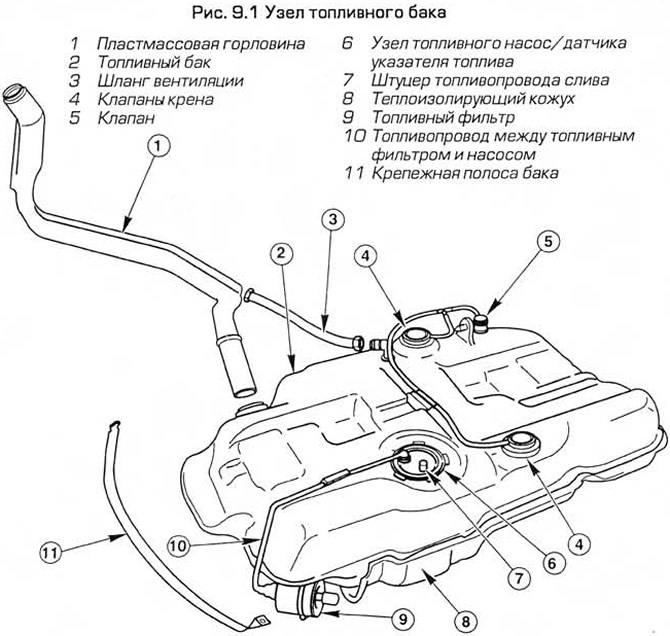
2. First disconnect the negative battery cable and pump out the remaining fuel from the tank with a syringe. Another option is to disconnect the pressure line from the fuel filter (Chapter 1) and attach a piece of hose to it so that when the ignition is turned on, the fuel pump pumps fuel from the tank into a clean container. The container must be large enough. Precautions must also be taken to prevent fire hazards.
Note: Before disconnecting or opening any component of the fuel system, relieve any residual pressure (paragraph 2), equalize the pressure in the tank by removing the tank cap, and also disconnect the negative battery cable (chapter 5 paragraph 1).
3. Turn out bolts or bend forward (depending on performance) rear seat cushion (chapter 11). Remove the plug that covers the fuel pump/fuel gauge sensor from the car's bottom.
4. Disconnect the fuel pump/pointer sensor electrical connector and disconnect the fuel drain line (Red) from the pump assembly (see paragraph 9).
5. Chock the front wheels. Raise the rear and place it on supports.
6. Preliminarily study the location of the tank elements, looking at the bottom from below.
Warning: If the vehicle is only supported by a jack, do not work under it!
7. Remove the fuel filter or disconnect the exhaust pipe from it (see chapter 1).
8. Remove the exhaust system from its rubber mounts. Lower the system onto a secure support so as not to create stress in the connection between the exhaust pipe and the exhaust manifold (paragraph 17) or remove the entire system.
9. Turn out bolts of clips of supports of the stabilizer of cross-section oscillations of a back suspension bracket (see fig. 9.9). Move the stabilizer by tilting it back as far as possible. If there is not enough space, remove the stabilizer (chapter 10).
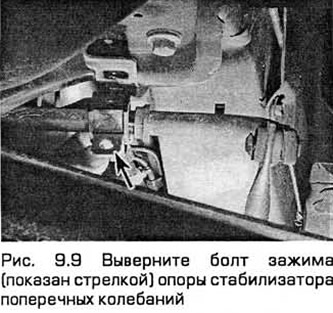
10. On release models prior to 01.1997, disconnect the ventilation hose from the plastic filler neck of the fuel tank as follows:
- A) On Sedan and Hatchback models, through the right rear suspension beam opening, release the clamp and pull the hose from the neck. This requires a reliable tool, small hands and experience (see fig. 9.10, a).
- b) On Station wagon models, loosen the clamp located above the rear anti-roll bar and pull the hose from the neck (see fig. 9.10.6).
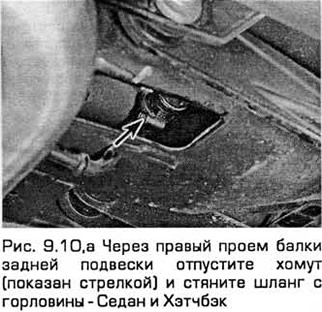
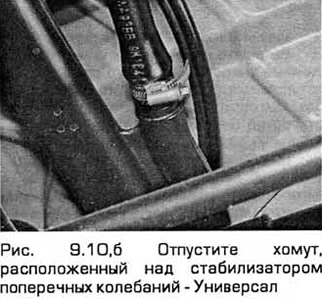
11. Turn away six fixing nuts and remove the back heat-insulating guard of an exhaust system from the bottom (see fig. 9.11).
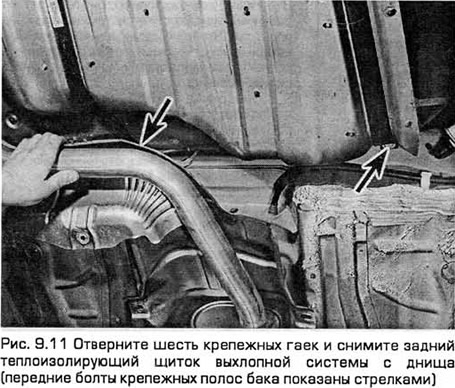
12. Support the tank with a mobile jack or something else, placing a reliable and rigid gasket under the tank.
13. Remove the bolt from the front of each mounting strip and rotate the strips down so that they hang under their own weight and do not interfere with the removal of the tank. Notice the ground wire located under the left strip bolt. Before installing the tank, it is necessary to clean the joint surfaces to ensure reliable contact of the wire with the strip.
14. Lower the tank just enough to unfasten the fuel drain line (Red) from its upper surface. Then disconnect the charcoal canister vacuum hose from the fitting located at the top of the tank at the rear (see fig. 9.14). On release models from 01.1997, disconnect the neck pipeline from the tank. So that you have no doubts during the subsequent installation, mark the fuel lines, hoses and corresponding fittings. Plug the hoses to keep dirt out and to prevent fuel leaks from them.
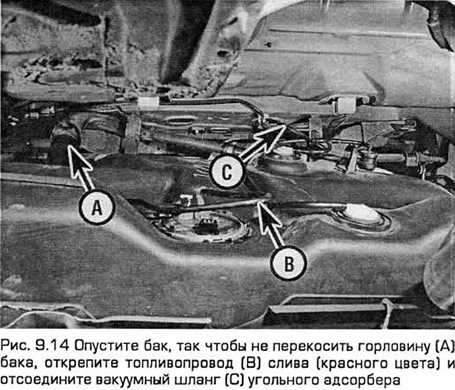
15. Remove the tank from the car, freeing it from the neck pipe. After removing the tank, unhook the fastening strips (turning them by 90°for this) and make sure that they, as well as the joints under them on the bottom, are in good condition.
16. After removing the tank, you can pull out the neck. It is fixed with a screw located in the opening of the neck, as well as with two bolts on the bottom of the body.
Inspection
17. The fuel tank must be repaired by a specialist. Even after flushing the fuel system, explosive vapors can remain in it and cause ignition during tank repairs.
18. If the tank is removed from the car, then it must not be placed near an open flame or where sparks are formed so that the fuel vapors contained in it do not ignite. Be especially careful when operating a gas burner inside a garage.
Installation
19. Installation - in the reverse order of removal.
Visitor comments